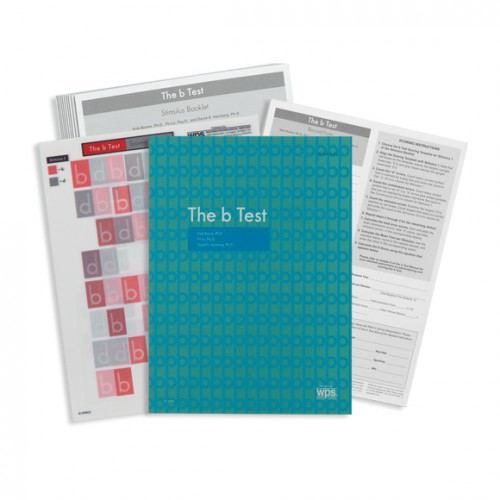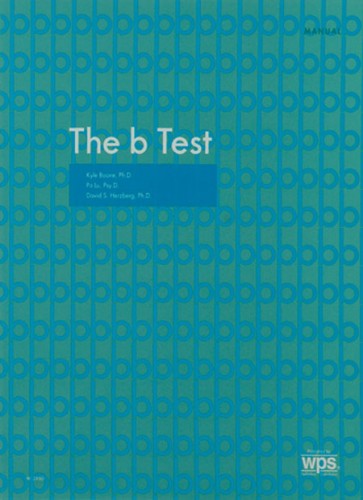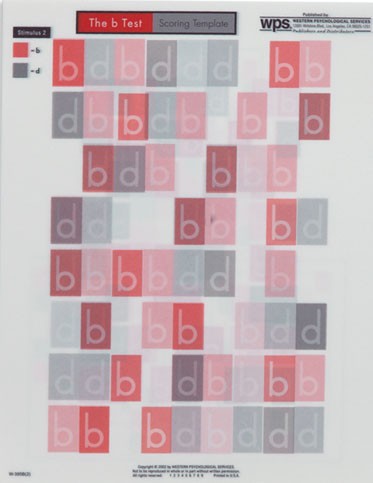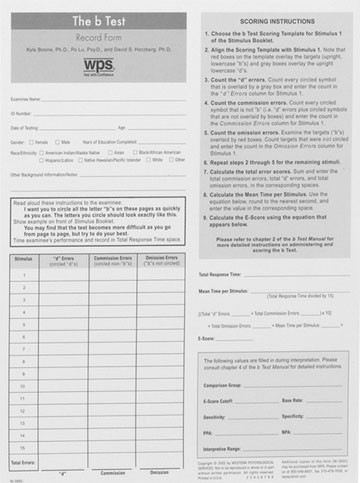b Test™
Complete Kit
- Ages 17 years and up
- Testing Time 5-15 minutes
- Administration Individual
-
Product Code W-395 ( MR #056670 )
* Qualifications required to purchase this item. Click here to complete the qualifications form.
* Regional restriction: This item is only available for sale within Canada.
Price $376.80
Contents
Like The Dot Counting Test (DCT), The b Test assesses test-taking effort in individuals ages 17 and older. Unlike the DCT, The b Test offers entirely new and unfamiliar stimuli, making it ideal for forensic use.
The b Test is a letter-recognition and discrimination task. It asks the examinee to circle, as quickly as possible, all the b’s that appear on each page of the Stimulus Booklet. Error Totals, plus time required to complete the task, are used to calculate an Effort Index Score.
Finding the b’s among the distracters is an easy task, even for people with brain injury or neurological disease. However, it appears more difficult than it is. The distracters (d’s and q’s, some with rotated stems) look quite similar to b’s. And on each successive page of the Stimulus Booklet, the letters grow smaller, suggesting increased difficulty.
Because The b Test assesses “overlearned” skills, individuals with cerebral dysfunction who try hard on the task will not be mistakenly classified as noncooperative. Similarly, examinees who are feigning symptoms may be tempted to display their “impairment,” in which case the test will flag their effort as suspect.
The b Test has several advantages over memory-based effort tests. Reading and letter recognition skills are usually preserved in patients with memory impairment. Thus, The b Test is less likely than memory-based effort tests to mistakenly find “suspect effort” in patients with actual memory disorders. Also, because people feign cognitive impairment selectively, The b Test is more likely than memory-based effort tests to detect faked deficits in letter recognition.
The b Test performance of 91 “suspect effort” patients (previously identified by rigorous inclusion and exclusion criteria) was compared to that of patients in six “normal effort” diagnostic groups: Depression, Schizophrenia, Head Injury, Stroke, Learning Disability, and Nonclinical. Results verified the ability of The b Test to discriminate among patients based on their effort status.
In interpreting test scores, you can select a cutoff that minimizes false positives while maintaining adequate sensitivity to “suspect effort.” Simply compare the patient’s performance to that of a similar reference group.
Like the DCT, The b Test is useful in any setting where examinees have external incentives to fabricate or exaggerate cognitive problems—personal injury litigation, disability evaluations, and criminal cases, for example. However, it need not be limited to these applications. There is increasing consensus among psychologists that effort tests should be a standard component of assessment practice.
Administered in less than 15 minutes, The b Test is a quick, cost-effective way to routinely assess test-taking effort.

 Proud to be Canadian
Proud to be Canadian



